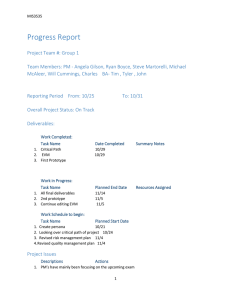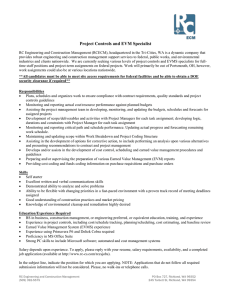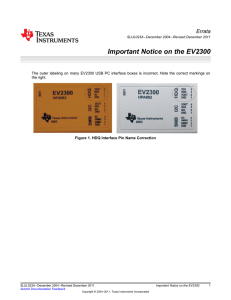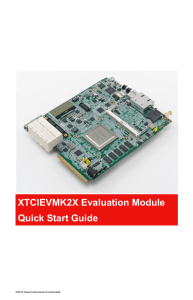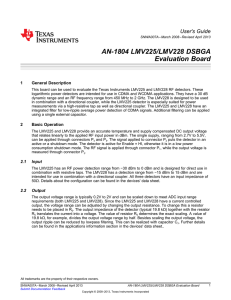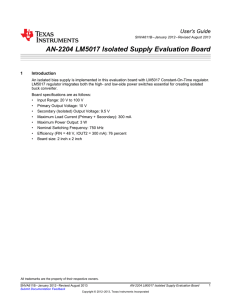OPT3001EVM User`s Guide (Rev. A)
advertisement
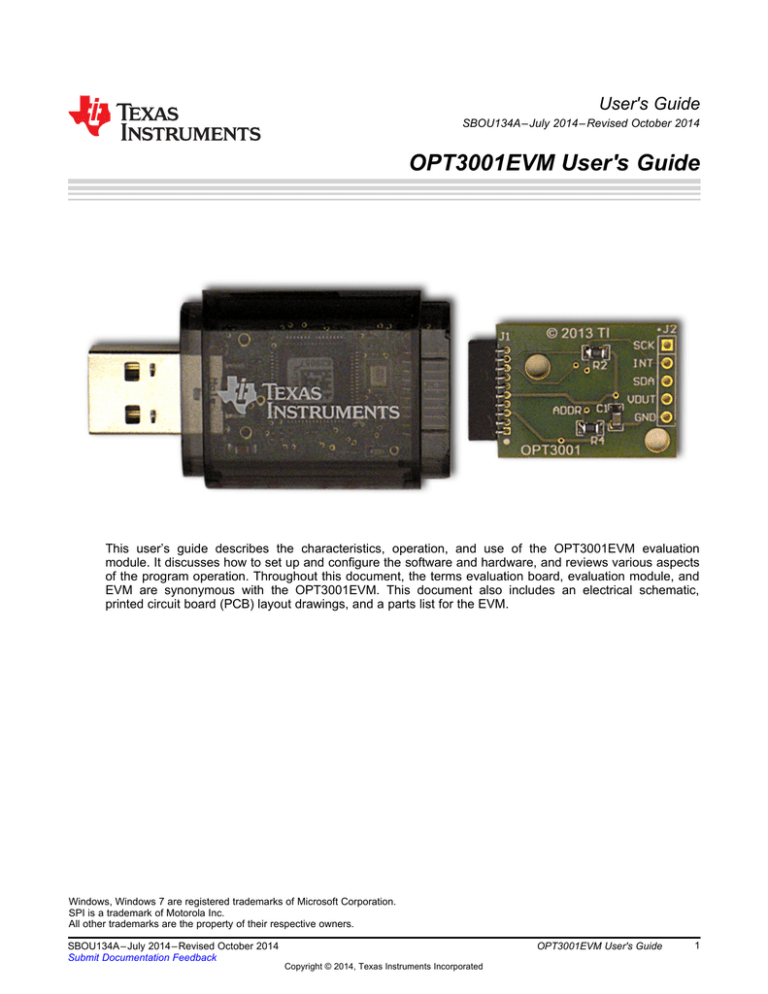
User's Guide SBOU134A – July 2014 – Revised October 2014 OPT3001EVM User's Guide This user’s guide describes the characteristics, operation, and use of the OPT3001EVM evaluation module. It discusses how to set up and configure the software and hardware, and reviews various aspects of the program operation. Throughout this document, the terms evaluation board, evaluation module, and EVM are synonymous with the OPT3001EVM. This document also includes an electrical schematic, printed circuit board (PCB) layout drawings, and a parts list for the EVM. Windows, Windows 7 are registered trademarks of Microsoft Corporation. SPI is a trademark of Motorola Inc. All other trademarks are the property of their respective owners. SBOU134A – July 2014 – Revised October 2014 Submit Documentation Feedback OPT3001EVM User's Guide Copyright © 2014, Texas Instruments Incorporated 1 www.ti.com 1 2 3 4 Contents Overview ..................................................................................................................... 3 1.1 OPT3001EVM Kit Contents ....................................................................................... 3 1.2 Related Documentation from Texas Instruments ............................................................... 4 OPT3001EVM Hardware ................................................................................................... 4 2.1 Theory of Operation for the OPT3001EVM ..................................................................... 5 2.2 OPT3001EVM Hardware Overview .............................................................................. 5 OPT3001EVM Software .................................................................................................... 7 3.1 Hardware Requirements ........................................................................................... 7 3.2 Software Installation ................................................................................................ 7 3.3 Launching the OPT3001EVM Software .......................................................................... 9 3.4 OPT3001EVM Software Operation ............................................................................. 10 Schematic, PCB Layout, and Bill of Materials .......................................................................... 14 4.1 Schematic .......................................................................................................... 14 4.2 PCB Layout ........................................................................................................ 15 4.3 Bill of Materials .................................................................................................... 17 List of Figures 1 Hardware Included with OPT3001EVM Kit ............................................................................... 3 2 OPT3001EVM Hardware Setup............................................................................................ 4 3 OPT3001 Test Board Block Diagram ..................................................................................... 5 4 Typical Hardware Connection .............................................................................................. 6 5 Typical Response After Connecting OPT3001EVM to the Computer ................................................ 6 6 OPT3001EVM Software-Installation Files ................................................................................ 7 7 OPT3001EVM Software-Installation Launch ............................................................................. 8 8 OPT3001EVM Software-Installation Prompts ............................................................................ 8 9 OPT3001 Main Operation Screen ......................................................................................... 9 10 Hardware Error Message ................................................................................................... 9 11 Power Indicators ............................................................................................................ 10 12 I2C Address Selection ...................................................................................................... 10 13 Register x00 Button and Recorded Values ............................................................................. 10 14 Register x01 Control and Status Register Bits ......................................................................... 11 15 Registers x02 and x03 Lux Limit Controls .............................................................................. 11 16 .................................................................................... ............................................................................................. Re-Initialize Button ......................................................................................................... Data Logging Setup and Enable ......................................................................................... Read All Button on the Register Map Tab with Example Output .................................................... OPT3001 Test-Board Schematic ......................................................................................... PCB Top Layer ............................................................................................................. PCB Bottom Layer ......................................................................................................... PCB Top-Layer Assembly Drawing ...................................................................................... PCB Bottom-Layer Assembly Drawing .................................................................................. 17 18 19 20 21 22 23 24 25 Simulated Screen Backlight Dimmer 11 Lux vs. Sample Number Plot 12 12 13 13 14 15 15 16 16 List of Tables 2 1 OPT3001EVM Kit Contents ................................................................................................ 3 2 Related Documentation ..................................................................................................... 4 3 OPT3001 Test Board Parts List ......................................................................................... OPT3001EVM User's Guide 17 SBOU134A – July 2014 – Revised October 2014 Submit Documentation Feedback Copyright © 2014, Texas Instruments Incorporated Overview www.ti.com 1 Overview The OPT3001 is an ambient light sensor (ALS) with a digital output integrated circuit. It uses a two-wire interface that works with the I2C protocol making it ideal for many applications. The OPT3001EVM is a platform for evaluating the performance of the OPT3001 under various conditions. The OPT3001EVM consists of two PCBs. The first is the SM-USB-DIG board that communicates with the computer, provides power, and sends and receives appropriate digital signals. The second is the OPT3001 test board, which contains the OPT3001 and its support circuitry. 1.1 OPT3001EVM Kit Contents Table 1 summarizes the contents of the OPT3001EVM kit. Figure 1 shows the included hardware. Contact the Texas Instruments Product Information Center nearest you if any component is missing. It is highly recommended that you also check the OPT3001 product folder on the TI web site at www.ti.com to verify you have the latest versions of the released software. Table 1. OPT3001EVM Kit Contents Item Quantity OPT3001 test board 1 SM-USB-DIG board 1 USB extension cable 1 SM-USB-DIG USB Cable OPT3001 Test Board Figure 1. Hardware Included with OPT3001EVM Kit SBOU134A – July 2014 – Revised October 2014 Submit Documentation Feedback OPT3001EVM User's Guide Copyright © 2014, Texas Instruments Incorporated 3 Overview 1.2 www.ti.com Related Documentation from Texas Instruments The following documents provide information regarding Texas Instruments' integrated circuits used in the assembly of the OPT3001EVM. This user's guide is available from the TI web site under literature number SBOU134. Any letter appended to the literature number corresponds to the document revision that is current at the time of the writing of this document. The latest revision can be found by clicking the link Table 2 and is also available from the TI web site, the Texas Instruments' Literature Response Center at (800) 477-8924, and the Product Information Center at (972) 644-5580. When ordering, identify the document by both title and literature number. Table 2. Related Documentation Document 2 Literature Number OPT3001 product data sheet SBOS681 SM-USB-DIG_Platform user's guide SBOU098 OPT3001EVM Hardware Figure 2 shows the system setup for the OPT3001EVM. The computer runs the graphical user interface (GUI) software that communicates with the SM-USB-DIG over a USB connection. The SM-USB-DIG translates the USB commands from the computer into power, I2C, SPI™, and general-purpose input/output (GPIO) commands for the OPT3001 test board. The OPT3001EVM does not require any additional components to operate. Figure 2. OPT3001EVM Hardware Setup 4 OPT3001EVM User's Guide SBOU134A – July 2014 – Revised October 2014 Submit Documentation Feedback Copyright © 2014, Texas Instruments Incorporated OPT3001EVM Hardware www.ti.com 2.1 Theory of Operation for the OPT3001EVM A block diagram of the OPT3001 test board hardware is shown in Figure 3. The OPT3001 test board contains connections for the power, I2C, and an interrupt signal. For evaluation purposes, the board also has a 5-pin header that allows the OPT3001 test board to be connected to hardware other than the SMUSB-DIG Platform. VDUT Supply (Switched +3.3-V Power) Interrupt 10-Pin, Female SM-USB-DIG Connector OPT3001 Five 100-mil-spaced test points 2 I C Interface Figure 3. OPT3001 Test Board Block Diagram 2.2 OPT3001EVM Hardware Overview If not already assembled, the basic hardware setup for the OPT3001EVM involves connecting the OPT3001 test board to the SM-USB-DIG Platform and then connecting the USB cable. This section presents the details of this procedure. CAUTION Many of the components on the OPT3001EVM are susceptible to damage by electrostatic discharge (ESD). Customers are advised to observe proper ESD handling precautions when unpacking and handling the EVM, including the use of a grounded wrist strap at an approved ESD workstation. 2.2.1 Typical OPT3001EVM Hardware Setup Connect the right-angle female socket on the OPT3001 test board to the right-angle male header on the SM-USB-DIG Platform, as shown in Figure 4. Take special care to make sure that the two 10-pin sockets directly align with each other. Plug the female USB-A cable to the SM-USB-DIG Platform and then plug the male USB-A cable into the computer. NOTE: Always connect the two boards together before connecting the USB cable to avoid any issues if the connectors are misaligned. SBOU134A – July 2014 – Revised October 2014 Submit Documentation Feedback OPT3001EVM User's Guide Copyright © 2014, Texas Instruments Incorporated 5 OPT3001EVM Hardware www.ti.com Figure 4. Typical Hardware Connection Figure 5 shows the typical response when the SM-USB-DIG is plugged into the USB port of the computer for the first time. Typically, the computer responds with a Found New Hardware, USB Device pop-up dialog window. The pop-up window then typically changes to Found New Hardware, USB Human Interface Device. This pop-up indicates that the device is ready to be used. The SM-USB-DIG Platform uses the human interface device drivers that are part of the Windows® operating system. Figure 5. Typical Response After Connecting OPT3001EVM to the Computer In some cases, the Add Hardware Wizard appears. If this installation prompt occurs, allow the device manager to install the human interface device drivers by clicking Yes at each request to install the drivers. 6 OPT3001EVM User's Guide SBOU134A – July 2014 – Revised October 2014 Submit Documentation Feedback Copyright © 2014, Texas Instruments Incorporated OPT3001EVM Software www.ti.com 3 OPT3001EVM Software This section describes the installation and operation of the OPT3001EVM software. 3.1 Hardware Requirements The OPT3001EVM software has been tested on the Windows 7® operating system (OS) with United States regional settings. The software should function correctly on other Windows operating systems. 3.2 Software Installation The OPT3001EVM software is included on the CD that is shipped with the EVM kit. It is also available through the OPT3001EVM Product Folder on the TI web site (www.ti.com). To install the software to your computer, insert the supplied CD into an available CD-ROM drive, navigate to the OPT3001EVM software folder, and open the installer directory. Launch the OPT3001EVM installation file, setup.exe, as shown in Figure 6 Figure 6. OPT3001EVM Software-Installation Files SBOU134A – July 2014 – Revised October 2014 Submit Documentation Feedback OPT3001EVM User's Guide Copyright © 2014, Texas Instruments Incorporated 7 OPT3001EVM Software www.ti.com The OPT3001EVM software then begins the installation process, as shown in Figure 7. Figure 7. OPT3001EVM Software-Installation Launch Follow the prompts as shown in Figure 8 to install the OPT3001EVM software. Figure 8. OPT3001EVM Software-Installation Prompts The OPT3001EVM GUI software is now installed. 8 OPT3001EVM User's Guide SBOU134A – July 2014 – Revised October 2014 Submit Documentation Feedback Copyright © 2014, Texas Instruments Incorporated OPT3001EVM Software www.ti.com 3.3 Launching the OPT3001EVM Software With the OPT3001EVM properly connected (see Figure 4), launch the EVM GUI software from the Windows Start menu. It is located in a folder titled OPT3001EVM. The software launches with a screen similar to that shown in Figure 9. Figure 9. OPT3001 Main Operation Screen If the message shown in Figure 10 appears when the OPT3001EVM GUI software is launched, disconnect all components of the OPT3001EVM kit, and repeat the hardware assembly and connection instructions. Figure 10. Hardware Error Message SBOU134A – July 2014 – Revised October 2014 Submit Documentation Feedback OPT3001EVM User's Guide Copyright © 2014, Texas Instruments Incorporated 9 OPT3001EVM Software 3.4 www.ti.com OPT3001EVM Software Operation This section primarily discusses how to operate the OPT3001EVM software. The GUI has a primary window that is used to configure and read from the OPT3001EVM, along with two other windows that are used to access different features of the OPT3001EVM. Basic GUI functionality and a description of the tabs are also presented in this section. 3.4.1 Getting Started With the hardware properly connected and the EVM software installed and operating, check to see that the power to the device is turned on by looking at the LED on the SM-USB-DIG board and at the VDUT indicator on the SM-USB-DIG tab in the GUI software, as shown in Figure 11. Figure 11. Power Indicators If the hardware address of the OPT3001EVM on the EVM board has not been reconfigured, then the address fields shown on the SM-USB-DIG tab in Figure 12 are set up correctly. Figure 12. I2C Address Selection To quickly start using the device, leave the default settings selected, and click the Write Reg x01 button, and then click the Run Continuously flip switch. The software then begins capturing lux data from the device. This quick start is a good test to make sure everything is operational. To stop the computer from capturing data and plotting, click Run Continuously again. 3.4.2 Feature Descriptions Register x00 is a read-only register that holds the range and converted value. These data are used (per the OPT3001 data sheet) to compute the lux output, labeled Reg x00 Lux in Figure 13. Click the Read Reg x00 button to update these fields and the plot with the latest values from the OPT3001EVM. Figure 13. Register x00 Button and Recorded Values 10 OPT3001EVM User's Guide SBOU134A – July 2014 – Revised October 2014 Submit Documentation Feedback Copyright © 2014, Texas Instruments Incorporated OPT3001EVM Software www.ti.com Register x01 configures the OPT3001 and provides feedback about the state of the device; the bit names and full descriptions are shown in the OPT3001 data sheet. Each of the configurable, read and write bits has a drop-down menu to select the appropriate value. Each of the read-only status bits has an associated small, green indicator. As shown in Figure 14, two buttons are provided to operate register x01 because some of the bits have read and write capability. Note that in Figure 14, the Lux Full Scale Range selection field has four identical automatic range modes: 0x0C-0x0F. Also, the Mode selection field has two identical continuous sampling options: 0x02 and 0x03. Figure 14. Register x01 Control and Status Register Bits Registers x02 and x03 enforce low and high limits, respectively, on the output ranges (exponent) and values (mantissa) from the OPT3001. These registers are programmed with the appropriate fields, as shown in Figure 15. Change the values of the data in these fields to write and read the values from the OPT3001; no button press is required. However, if values are manually entered, exit the text field for the field to update. Figure 15. Registers x02 and x03 Lux Limit Controls There is a simulated screen backlight dimmer represented by a rectangle, shown in Figure 16. This rectangle changes from black, through 254 shades of grey, to white depending on the value of lux measured by the OPT3001. It shows a brighter backlight for high-lux situations and a dim backlight for low-lux situations. The low limit (darkest backlight) is always 0, and the high limit (brightest backlight) can be adjusted with the Lux for White numeric field. Figure 16. Simulated Screen Backlight Dimmer SBOU134A – July 2014 – Revised October 2014 Submit Documentation Feedback OPT3001EVM User's Guide Copyright © 2014, Texas Instruments Incorporated 11 OPT3001EVM Software www.ti.com The software provides a plot of the register x01 output labeled Lux vs Sample Number, as shown in Figure 17. As readings are collected, the plot is updated with those values. The y-axis is autoscaled to show the magnitude of the lux value recorded, and has a visible history of 100 samples along the x-axis. The plot can be reset by returning to the SM-USB-DIG tab and clicking the Re-Initialize button, as shown in Figure 18. Access the plot axis range and formatting by right-clicking the plot. Figure 17. Lux vs. Sample Number Plot Figure 18. Re-Initialize Button 12 OPT3001EVM User's Guide SBOU134A – July 2014 – Revised October 2014 Submit Documentation Feedback Copyright © 2014, Texas Instruments Incorporated OPT3001EVM Software www.ti.com There is a data logging feature included in the software, as shown in Figure 19. This feature allows the user to record the date and time from the host computer, along with the measured lux value reported by the device. After a destination file is selected by clicking Select a File/Path, turning on the Logging On/Off selector switch appends data to that file in .tab format. Figure 19. Data Logging Setup and Enable Under the final tab, Register Map, shown in Figure 20, there is a button labeled Read All. Clicking this button reads registers x00 through x0F and displays the results to the Register Table spreadsheet. In this way, all register values, including the values of x0E and x0F, can be easily verified to match the values shown in the data sheet. Figure 20. Read All Button on the Register Map Tab with Example Output SBOU134A – July 2014 – Revised October 2014 Submit Documentation Feedback OPT3001EVM User's Guide Copyright © 2014, Texas Instruments Incorporated 13 Schematic, PCB Layout, and Bill of Materials www.ti.com 4 Schematic, PCB Layout, and Bill of Materials 4.1 Schematic Figure 21 shows the complete schematic of the OPT3001 test board. SDA and SCK are pulled up by the SM-USB-DIG Platform so there are no pull-up resistors present. R2 is a pull-up resistor for the interrupt signal. C1 is a bypass capacitor for VDUT, and R4 is a jumper to tie the address pin to ground. If another address is desired, remove R4 and install a wire to the pad or via, and then to the appropriate signal source. J2 1 2 3 4 5 GND Do Not Install SCK INT SDA VDUT GND VDUT TSW-105-07-G-S SDA INT SCK SM-USB-DIG Header J1 1 2 3 4 5 6 7 8 9 10 851-43-010-20-001000 VDUT C1 0.1µF R2 10k U1 1 R4 0 GND 2 3 VDD ADDR GND SDA INT SCL 6 SDA 5 4 INT SCK OPT3001DNP Figure 21. OPT3001 Test-Board Schematic The OPT3001 is mounted on the back side of the board so that the LED light from the SM-USB-DIG is directed away from the device. Also, no additional LEDs are installed on the test board to reduce total ambient light around the device. The back side of the board is mostly planar; mounting holes are included to accommodate evaluation. 14 OPT3001EVM User's Guide SBOU134A – July 2014 – Revised October 2014 Submit Documentation Feedback Copyright © 2014, Texas Instruments Incorporated Schematic, PCB Layout, and Bill of Materials www.ti.com 4.2 PCB Layout Figure 22 and Figure 23 show the top and bottom PCB layers, respectively, of the test board. Figure 24 and Figure 25 show the assembly drawings of the top and bottom PCB layers, respectively. Figure 22. PCB Top Layer Figure 23. PCB Bottom Layer SBOU134A – July 2014 – Revised October 2014 Submit Documentation Feedback OPT3001EVM User's Guide Copyright © 2014, Texas Instruments Incorporated 15 Schematic, PCB Layout, and Bill of Materials www.ti.com Figure 24. PCB Top-Layer Assembly Drawing Figure 25. PCB Bottom-Layer Assembly Drawing 16 OPT3001EVM User's Guide SBOU134A – July 2014 – Revised October 2014 Submit Documentation Feedback Copyright © 2014, Texas Instruments Incorporated Schematic, PCB Layout, and Bill of Materials www.ti.com 4.3 Bill of Materials Table 3 lists the bill of materials for the OPT3001 test board. Table 3. OPT3001 Test Board Parts List Qty RefDes 1 C1 CAP, CERM, 0.1uF, 50V, +/-10%, X7R, 0805 Description 08055C104KAT2A Part Number AVX Corp. MFR 1 J1 Receptacle, 50mil 10x1, R/A, TH 851-43-010-20-001000 Mill-Max 1 R2 RES, 10k ohm, 5%, 0.125W, 0805 CRCW080510K0JNEA Vishay Dale 1 R4 RES, 0 ohm, 5%, 0.125W, 0805 CRCW08050000Z0EA Vishay Dale 1 U1 Ambient Light Sensor, DNP0006A OPT3001DNP Texas Instruments Revision History Changes from Original (July 2014) to A Revision ........................................................................................................... Page • Deleted row regarding CD-ROM from Table 1 ........................................................................................ 3 SBOU134A – July 2014 – Revised October 2014 Submit Documentation Feedback Revision History Copyright © 2014, Texas Instruments Incorporated 17 STANDARD TERMS AND CONDITIONS FOR EVALUATION MODULES 1. Delivery: TI delivers TI evaluation boards, kits, or modules, including any accompanying demonstration software, components, or documentation (collectively, an “EVM” or “EVMs”) to the User (“User”) in accordance with the terms and conditions set forth herein. Acceptance of the EVM is expressly subject to the following terms and conditions. 1.1 EVMs are intended solely for product or software developers for use in a research and development setting to facilitate feasibility evaluation, experimentation, or scientific analysis of TI semiconductors products. EVMs have no direct function and are not finished products. EVMs shall not be directly or indirectly assembled as a part or subassembly in any finished product. For clarification, any software or software tools provided with the EVM (“Software”) shall not be subject to the terms and conditions set forth herein but rather shall be subject to the applicable terms and conditions that accompany such Software 1.2 EVMs are not intended for consumer or household use. EVMs may not be sold, sublicensed, leased, rented, loaned, assigned, or otherwise distributed for commercial purposes by Users, in whole or in part, or used in any finished product or production system. 2 Limited Warranty and Related Remedies/Disclaimers: 2.1 These terms and conditions do not apply to Software. The warranty, if any, for Software is covered in the applicable Software License Agreement. 2.2 TI warrants that the TI EVM will conform to TI's published specifications for ninety (90) days after the date TI delivers such EVM to User. Notwithstanding the foregoing, TI shall not be liable for any defects that are caused by neglect, misuse or mistreatment by an entity other than TI, including improper installation or testing, or for any EVMs that have been altered or modified in any way by an entity other than TI. Moreover, TI shall not be liable for any defects that result from User's design, specifications or instructions for such EVMs. Testing and other quality control techniques are used to the extent TI deems necessary or as mandated by government requirements. TI does not test all parameters of each EVM. 2.3 If any EVM fails to conform to the warranty set forth above, TI's sole liability shall be at its option to repair or replace such EVM, or credit User's account for such EVM. TI's liability under this warranty shall be limited to EVMs that are returned during the warranty period to the address designated by TI and that are determined by TI not to conform to such warranty. If TI elects to repair or replace such EVM, TI shall have a reasonable time to repair such EVM or provide replacements. Repaired EVMs shall be warranted for the remainder of the original warranty period. Replaced EVMs shall be warranted for a new full ninety (90) day warranty period. 3 Regulatory Notices: 3.1 United States 3.1.1 Notice applicable to EVMs not FCC-Approved: This kit is designed to allow product developers to evaluate electronic components, circuitry, or software associated with the kit to determine whether to incorporate such items in a finished product and software developers to write software applications for use with the end product. This kit is not a finished product and when assembled may not be resold or otherwise marketed unless all required FCC equipment authorizations are first obtained. Operation is subject to the condition that this product not cause harmful interference to licensed radio stations and that this product accept harmful interference. Unless the assembled kit is designed to operate under part 15, part 18 or part 95 of this chapter, the operator of the kit must operate under the authority of an FCC license holder or must secure an experimental authorization under part 5 of this chapter. 3.1.2 For EVMs annotated as FCC – FEDERAL COMMUNICATIONS COMMISSION Part 15 Compliant: CAUTION This device complies with part 15 of the FCC Rules. Operation is subject to the following two conditions: (1) This device may not cause harmful interference, and (2) this device must accept any interference received, including interference that may cause undesired operation. Changes or modifications not expressly approved by the party responsible for compliance could void the user's authority to operate the equipment. FCC Interference Statement for Class A EVM devices NOTE: This equipment has been tested and found to comply with the limits for a Class A digital device, pursuant to part 15 of the FCC Rules. These limits are designed to provide reasonable protection against harmful interference when the equipment is operated in a commercial environment. This equipment generates, uses, and can radiate radio frequency energy and, if not installed and used in accordance with the instruction manual, may cause harmful interference to radio communications. Operation of this equipment in a residential area is likely to cause harmful interference in which case the user will be required to correct the interference at his own expense. SPACER SPACER SPACER SPACER SPACER SPACER SPACER SPACER FCC Interference Statement for Class B EVM devices NOTE: This equipment has been tested and found to comply with the limits for a Class B digital device, pursuant to part 15 of the FCC Rules. These limits are designed to provide reasonable protection against harmful interference in a residential installation. This equipment generates, uses and can radiate radio frequency energy and, if not installed and used in accordance with the instructions, may cause harmful interference to radio communications. However, there is no guarantee that interference will not occur in a particular installation. If this equipment does cause harmful interference to radio or television reception, which can be determined by turning the equipment off and on, the user is encouraged to try to correct the interference by one or more of the following measures: • • • • Reorient or relocate the receiving antenna. Increase the separation between the equipment and receiver. Connect the equipment into an outlet on a circuit different from that to which the receiver is connected. Consult the dealer or an experienced radio/TV technician for help. 3.2 Canada 3.2.1 For EVMs issued with an Industry Canada Certificate of Conformance to RSS-210 Concerning EVMs Including Radio Transmitters: This device complies with Industry Canada license-exempt RSS standard(s). Operation is subject to the following two conditions: (1) this device may not cause interference, and (2) this device must accept any interference, including interference that may cause undesired operation of the device. Concernant les EVMs avec appareils radio: Le présent appareil est conforme aux CNR d'Industrie Canada applicables aux appareils radio exempts de licence. L'exploitation est autorisée aux deux conditions suivantes: (1) l'appareil ne doit pas produire de brouillage, et (2) l'utilisateur de l'appareil doit accepter tout brouillage radioélectrique subi, même si le brouillage est susceptible d'en compromettre le fonctionnement. Concerning EVMs Including Detachable Antennas: Under Industry Canada regulations, this radio transmitter may only operate using an antenna of a type and maximum (or lesser) gain approved for the transmitter by Industry Canada. To reduce potential radio interference to other users, the antenna type and its gain should be so chosen that the equivalent isotropically radiated power (e.i.r.p.) is not more than that necessary for successful communication. This radio transmitter has been approved by Industry Canada to operate with the antenna types listed in the user guide with the maximum permissible gain and required antenna impedance for each antenna type indicated. Antenna types not included in this list, having a gain greater than the maximum gain indicated for that type, are strictly prohibited for use with this device. Concernant les EVMs avec antennes détachables Conformément à la réglementation d'Industrie Canada, le présent émetteur radio peut fonctionner avec une antenne d'un type et d'un gain maximal (ou inférieur) approuvé pour l'émetteur par Industrie Canada. Dans le but de réduire les risques de brouillage radioélectrique à l'intention des autres utilisateurs, il faut choisir le type d'antenne et son gain de sorte que la puissance isotrope rayonnée équivalente (p.i.r.e.) ne dépasse pas l'intensité nécessaire à l'établissement d'une communication satisfaisante. Le présent émetteur radio a été approuvé par Industrie Canada pour fonctionner avec les types d'antenne énumérés dans le manuel d’usage et ayant un gain admissible maximal et l'impédance requise pour chaque type d'antenne. Les types d'antenne non inclus dans cette liste, ou dont le gain est supérieur au gain maximal indiqué, sont strictement interdits pour l'exploitation de l'émetteur 3.3 Japan 3.3.1 Notice for EVMs delivered in Japan: Please see http://www.tij.co.jp/lsds/ti_ja/general/eStore/notice_01.page 日本国内に 輸入される評価用キット、ボードについては、次のところをご覧ください。 http://www.tij.co.jp/lsds/ti_ja/general/eStore/notice_01.page 3.3.2 Notice for Users of EVMs Considered “Radio Frequency Products” in Japan: EVMs entering Japan are NOT certified by TI as conforming to Technical Regulations of Radio Law of Japan. If User uses EVMs in Japan, User is required by Radio Law of Japan to follow the instructions below with respect to EVMs: 1. 2. 3. Use EVMs in a shielded room or any other test facility as defined in the notification #173 issued by Ministry of Internal Affairs and Communications on March 28, 2006, based on Sub-section 1.1 of Article 6 of the Ministry’s Rule for Enforcement of Radio Law of Japan, Use EVMs only after User obtains the license of Test Radio Station as provided in Radio Law of Japan with respect to EVMs, or Use of EVMs only after User obtains the Technical Regulations Conformity Certification as provided in Radio Law of Japan with respect to EVMs. Also, do not transfer EVMs, unless User gives the same notice above to the transferee. Please note that if User does not follow the instructions above, User will be subject to penalties of Radio Law of Japan. SPACER SPACER SPACER SPACER SPACER 【無線電波を送信する製品の開発キットをお使いになる際の注意事項】 本開発キットは技術基準適合証明を受けておりません。 本製品のご使用に際しては、電波法遵守のため、以下のいずれかの措置を取っていただく必要がありますのでご注意ください。 1. 2. 3. 電波法施行規則第6条第1項第1号に基づく平成18年3月28日総務省告示第173号で定められた電波暗室等の試験設備でご使用 いただく。 実験局の免許を取得後ご使用いただく。 技術基準適合証明を取得後ご使用いただく。 なお、本製品は、上記の「ご使用にあたっての注意」を譲渡先、移転先に通知しない限り、譲渡、移転できないものとします。 上記を遵守頂けない場合は、電波法の罰則が適用される可能性があることをご留意ください。 日本テキサス・インスツルメンツ株式会社 東京都新宿区西新宿6丁目24番1号 西新宿三井ビル 3.3.3 Notice for EVMs for Power Line Communication: Please see http://www.tij.co.jp/lsds/ti_ja/general/eStore/notice_02.page 電力線搬送波通信についての開発キットをお使いになる際の注意事項については、次のところをご覧くださ い。http://www.tij.co.jp/lsds/ti_ja/general/eStore/notice_02.page SPACER 4 EVM Use Restrictions and Warnings: 4.1 EVMS ARE NOT FOR USE IN FUNCTIONAL SAFETY AND/OR SAFETY CRITICAL EVALUATIONS, INCLUDING BUT NOT LIMITED TO EVALUATIONS OF LIFE SUPPORT APPLICATIONS. 4.2 User must read and apply the user guide and other available documentation provided by TI regarding the EVM prior to handling or using the EVM, including without limitation any warning or restriction notices. The notices contain important safety information related to, for example, temperatures and voltages. 4.3 Safety-Related Warnings and Restrictions: 4.3.1 User shall operate the EVM within TI’s recommended specifications and environmental considerations stated in the user guide, other available documentation provided by TI, and any other applicable requirements and employ reasonable and customary safeguards. Exceeding the specified performance ratings and specifications (including but not limited to input and output voltage, current, power, and environmental ranges) for the EVM may cause personal injury or death, or property damage. If there are questions concerning performance ratings and specifications, User should contact a TI field representative prior to connecting interface electronics including input power and intended loads. Any loads applied outside of the specified output range may also result in unintended and/or inaccurate operation and/or possible permanent damage to the EVM and/or interface electronics. Please consult the EVM user guide prior to connecting any load to the EVM output. If there is uncertainty as to the load specification, please contact a TI field representative. During normal operation, even with the inputs and outputs kept within the specified allowable ranges, some circuit components may have elevated case temperatures. These components include but are not limited to linear regulators, switching transistors, pass transistors, current sense resistors, and heat sinks, which can be identified using the information in the associated documentation. When working with the EVM, please be aware that the EVM may become very warm. 4.3.2 EVMs are intended solely for use by technically qualified, professional electronics experts who are familiar with the dangers and application risks associated with handling electrical mechanical components, systems, and subsystems. User assumes all responsibility and liability for proper and safe handling and use of the EVM by User or its employees, affiliates, contractors or designees. User assumes all responsibility and liability to ensure that any interfaces (electronic and/or mechanical) between the EVM and any human body are designed with suitable isolation and means to safely limit accessible leakage currents to minimize the risk of electrical shock hazard. User assumes all responsibility and liability for any improper or unsafe handling or use of the EVM by User or its employees, affiliates, contractors or designees. 4.4 User assumes all responsibility and liability to determine whether the EVM is subject to any applicable international, federal, state, or local laws and regulations related to User’s handling and use of the EVM and, if applicable, User assumes all responsibility and liability for compliance in all respects with such laws and regulations. User assumes all responsibility and liability for proper disposal and recycling of the EVM consistent with all applicable international, federal, state, and local requirements. 5. Accuracy of Information: To the extent TI provides information on the availability and function of EVMs, TI attempts to be as accurate as possible. However, TI does not warrant the accuracy of EVM descriptions, EVM availability or other information on its websites as accurate, complete, reliable, current, or error-free. SPACER SPACER SPACER SPACER SPACER SPACER SPACER 6. Disclaimers: 6.1 EXCEPT AS SET FORTH ABOVE, EVMS AND ANY WRITTEN DESIGN MATERIALS PROVIDED WITH THE EVM (AND THE DESIGN OF THE EVM ITSELF) ARE PROVIDED "AS IS" AND "WITH ALL FAULTS." TI DISCLAIMS ALL OTHER WARRANTIES, EXPRESS OR IMPLIED, REGARDING SUCH ITEMS, INCLUDING BUT NOT LIMITED TO ANY IMPLIED WARRANTIES OF MERCHANTABILITY OR FITNESS FOR A PARTICULAR PURPOSE OR NON-INFRINGEMENT OF ANY THIRD PARTY PATENTS, COPYRIGHTS, TRADE SECRETS OR OTHER INTELLECTUAL PROPERTY RIGHTS. 6.2 EXCEPT FOR THE LIMITED RIGHT TO USE THE EVM SET FORTH HEREIN, NOTHING IN THESE TERMS AND CONDITIONS SHALL BE CONSTRUED AS GRANTING OR CONFERRING ANY RIGHTS BY LICENSE, PATENT, OR ANY OTHER INDUSTRIAL OR INTELLECTUAL PROPERTY RIGHT OF TI, ITS SUPPLIERS/LICENSORS OR ANY OTHER THIRD PARTY, TO USE THE EVM IN ANY FINISHED END-USER OR READY-TO-USE FINAL PRODUCT, OR FOR ANY INVENTION, DISCOVERY OR IMPROVEMENT MADE, CONCEIVED OR ACQUIRED PRIOR TO OR AFTER DELIVERY OF THE EVM. 7. USER'S INDEMNITY OBLIGATIONS AND REPRESENTATIONS. USER WILL DEFEND, INDEMNIFY AND HOLD TI, ITS LICENSORS AND THEIR REPRESENTATIVES HARMLESS FROM AND AGAINST ANY AND ALL CLAIMS, DAMAGES, LOSSES, EXPENSES, COSTS AND LIABILITIES (COLLECTIVELY, "CLAIMS") ARISING OUT OF OR IN CONNECTION WITH ANY HANDLING OR USE OF THE EVM THAT IS NOT IN ACCORDANCE WITH THESE TERMS AND CONDITIONS. THIS OBLIGATION SHALL APPLY WHETHER CLAIMS ARISE UNDER STATUTE, REGULATION, OR THE LAW OF TORT, CONTRACT OR ANY OTHER LEGAL THEORY, AND EVEN IF THE EVM FAILS TO PERFORM AS DESCRIBED OR EXPECTED. 8. Limitations on Damages and Liability: 8.1 General Limitations. IN NO EVENT SHALL TI BE LIABLE FOR ANY SPECIAL, COLLATERAL, INDIRECT, PUNITIVE, INCIDENTAL, CONSEQUENTIAL, OR EXEMPLARY DAMAGES IN CONNECTION WITH OR ARISING OUT OF THESE TERMS ANDCONDITIONS OR THE USE OF THE EVMS PROVIDED HEREUNDER, REGARDLESS OF WHETHER TI HAS BEEN ADVISED OF THE POSSIBILITY OF SUCH DAMAGES. EXCLUDED DAMAGES INCLUDE, BUT ARE NOT LIMITED TO, COST OF REMOVAL OR REINSTALLATION, ANCILLARY COSTS TO THE PROCUREMENT OF SUBSTITUTE GOODS OR SERVICES, RETESTING, OUTSIDE COMPUTER TIME, LABOR COSTS, LOSS OF GOODWILL, LOSS OF PROFITS, LOSS OF SAVINGS, LOSS OF USE, LOSS OF DATA, OR BUSINESS INTERRUPTION. NO CLAIM, SUIT OR ACTION SHALL BE BROUGHT AGAINST TI MORE THAN ONE YEAR AFTER THE RELATED CAUSE OF ACTION HAS OCCURRED. 8.2 Specific Limitations. IN NO EVENT SHALL TI'S AGGREGATE LIABILITY FROM ANY WARRANTY OR OTHER OBLIGATION ARISING OUT OF OR IN CONNECTION WITH THESE TERMS AND CONDITIONS, OR ANY USE OF ANY TI EVM PROVIDED HEREUNDER, EXCEED THE TOTAL AMOUNT PAID TO TI FOR THE PARTICULAR UNITS SOLD UNDER THESE TERMS AND CONDITIONS WITH RESPECT TO WHICH LOSSES OR DAMAGES ARE CLAIMED. THE EXISTENCE OF MORE THAN ONE CLAIM AGAINST THE PARTICULAR UNITS SOLD TO USER UNDER THESE TERMS AND CONDITIONS SHALL NOT ENLARGE OR EXTEND THIS LIMIT. 9. Return Policy. Except as otherwise provided, TI does not offer any refunds, returns, or exchanges. Furthermore, no return of EVM(s) will be accepted if the package has been opened and no return of the EVM(s) will be accepted if they are damaged or otherwise not in a resalable condition. If User feels it has been incorrectly charged for the EVM(s) it ordered or that delivery violates the applicable order, User should contact TI. All refunds will be made in full within thirty (30) working days from the return of the components(s), excluding any postage or packaging costs. 10. Governing Law: These terms and conditions shall be governed by and interpreted in accordance with the laws of the State of Texas, without reference to conflict-of-laws principles. User agrees that non-exclusive jurisdiction for any dispute arising out of or relating to these terms and conditions lies within courts located in the State of Texas and consents to venue in Dallas County, Texas. Notwithstanding the foregoing, any judgment may be enforced in any United States or foreign court, and TI may seek injunctive relief in any United States or foreign court. Mailing Address: Texas Instruments, Post Office Box 655303, Dallas, Texas 75265 Copyright © 2014, Texas Instruments Incorporated spacer IMPORTANT NOTICE Texas Instruments Incorporated and its subsidiaries (TI) reserve the right to make corrections, enhancements, improvements and other changes to its semiconductor products and services per JESD46, latest issue, and to discontinue any product or service per JESD48, latest issue. Buyers should obtain the latest relevant information before placing orders and should verify that such information is current and complete. All semiconductor products (also referred to herein as “components”) are sold subject to TI’s terms and conditions of sale supplied at the time of order acknowledgment. TI warrants performance of its components to the specifications applicable at the time of sale, in accordance with the warranty in TI’s terms and conditions of sale of semiconductor products. Testing and other quality control techniques are used to the extent TI deems necessary to support this warranty. Except where mandated by applicable law, testing of all parameters of each component is not necessarily performed. TI assumes no liability for applications assistance or the design of Buyers’ products. Buyers are responsible for their products and applications using TI components. To minimize the risks associated with Buyers’ products and applications, Buyers should provide adequate design and operating safeguards. TI does not warrant or represent that any license, either express or implied, is granted under any patent right, copyright, mask work right, or other intellectual property right relating to any combination, machine, or process in which TI components or services are used. Information published by TI regarding third-party products or services does not constitute a license to use such products or services or a warranty or endorsement thereof. Use of such information may require a license from a third party under the patents or other intellectual property of the third party, or a license from TI under the patents or other intellectual property of TI. Reproduction of significant portions of TI information in TI data books or data sheets is permissible only if reproduction is without alteration and is accompanied by all associated warranties, conditions, limitations, and notices. TI is not responsible or liable for such altered documentation. Information of third parties may be subject to additional restrictions. Resale of TI components or services with statements different from or beyond the parameters stated by TI for that component or service voids all express and any implied warranties for the associated TI component or service and is an unfair and deceptive business practice. TI is not responsible or liable for any such statements. Buyer acknowledges and agrees that it is solely responsible for compliance with all legal, regulatory and safety-related requirements concerning its products, and any use of TI components in its applications, notwithstanding any applications-related information or support that may be provided by TI. Buyer represents and agrees that it has all the necessary expertise to create and implement safeguards which anticipate dangerous consequences of failures, monitor failures and their consequences, lessen the likelihood of failures that might cause harm and take appropriate remedial actions. Buyer will fully indemnify TI and its representatives against any damages arising out of the use of any TI components in safety-critical applications. In some cases, TI components may be promoted specifically to facilitate safety-related applications. With such components, TI’s goal is to help enable customers to design and create their own end-product solutions that meet applicable functional safety standards and requirements. Nonetheless, such components are subject to these terms. No TI components are authorized for use in FDA Class III (or similar life-critical medical equipment) unless authorized officers of the parties have executed a special agreement specifically governing such use. Only those TI components which TI has specifically designated as military grade or “enhanced plastic” are designed and intended for use in military/aerospace applications or environments. Buyer acknowledges and agrees that any military or aerospace use of TI components which have not been so designated is solely at the Buyer's risk, and that Buyer is solely responsible for compliance with all legal and regulatory requirements in connection with such use. TI has specifically designated certain components as meeting ISO/TS16949 requirements, mainly for automotive use. In any case of use of non-designated products, TI will not be responsible for any failure to meet ISO/TS16949. Products Applications Audio www.ti.com/audio Automotive and Transportation www.ti.com/automotive Amplifiers amplifier.ti.com Communications and Telecom www.ti.com/communications Data Converters dataconverter.ti.com Computers and Peripherals www.ti.com/computers DLP® Products www.dlp.com Consumer Electronics www.ti.com/consumer-apps DSP dsp.ti.com Energy and Lighting www.ti.com/energy Clocks and Timers www.ti.com/clocks Industrial www.ti.com/industrial Interface interface.ti.com Medical www.ti.com/medical Logic logic.ti.com Security www.ti.com/security Power Mgmt power.ti.com Space, Avionics and Defense www.ti.com/space-avionics-defense Microcontrollers microcontroller.ti.com Video and Imaging www.ti.com/video RFID www.ti-rfid.com OMAP Applications Processors www.ti.com/omap TI E2E Community e2e.ti.com Wireless Connectivity www.ti.com/wirelessconnectivity Mailing Address: Texas Instruments, Post Office Box 655303, Dallas, Texas 75265 Copyright © 2014, Texas Instruments Incorporated
